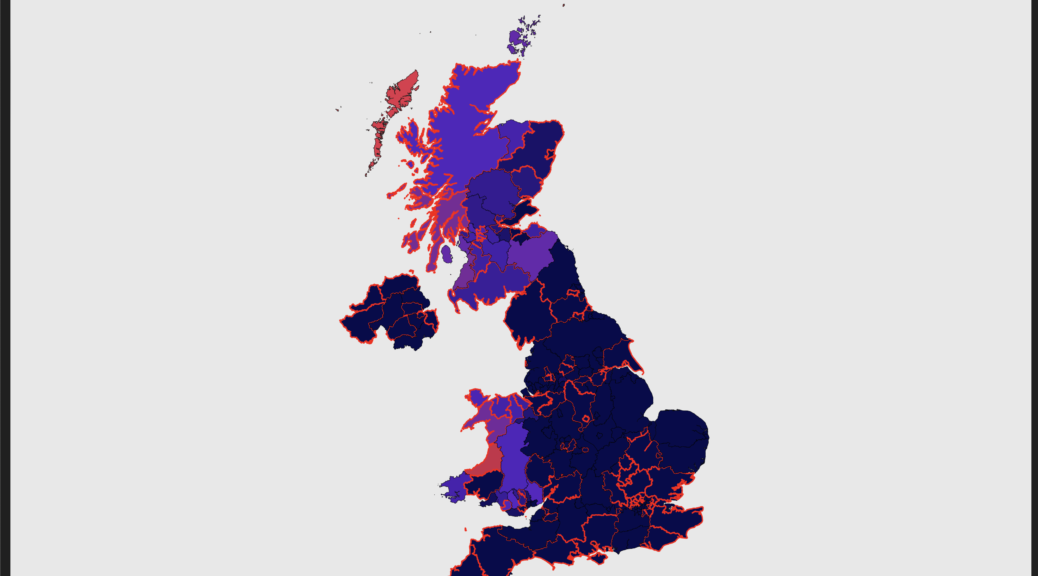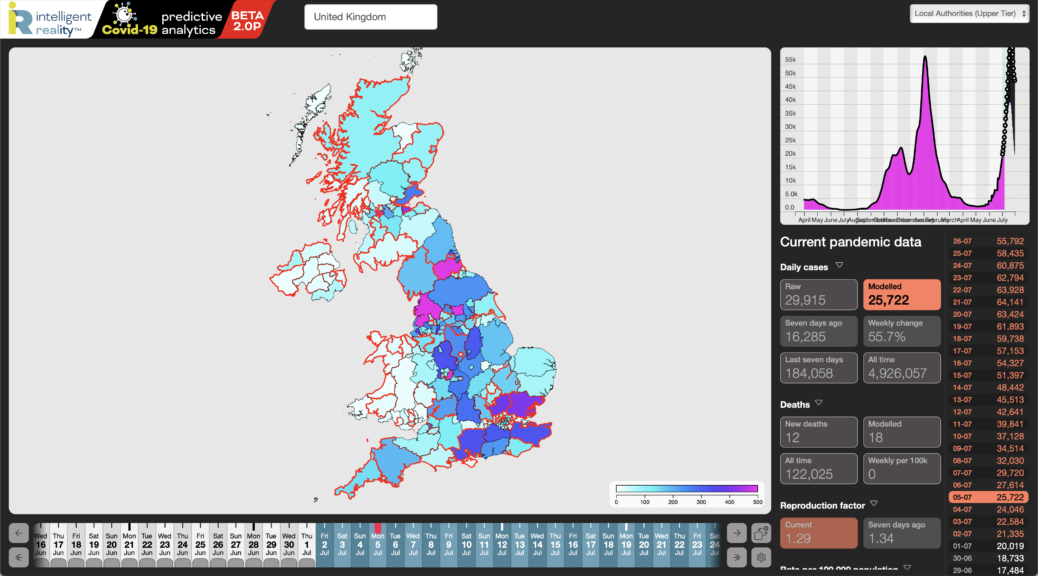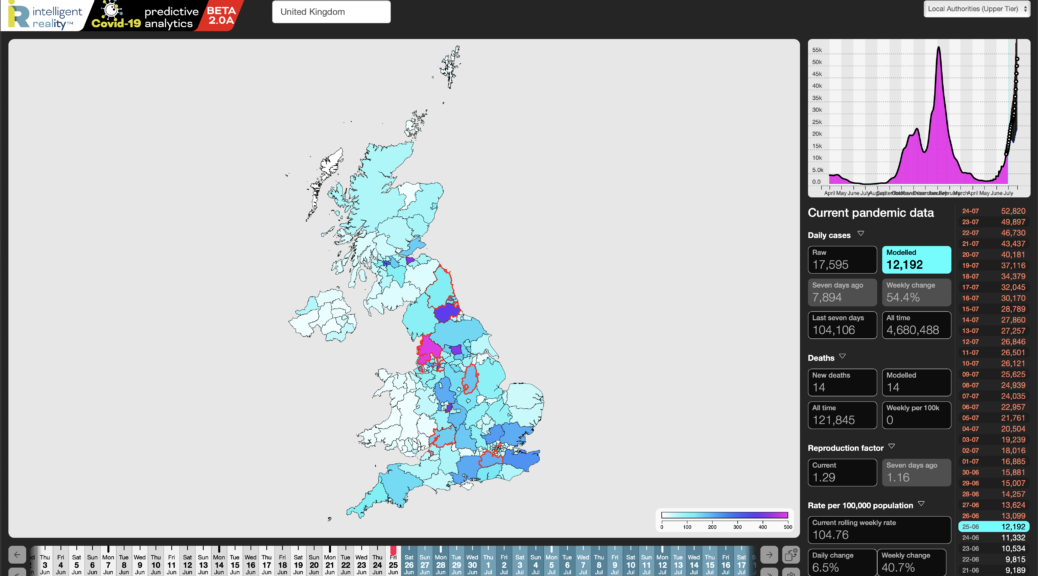The UK’s ‘Prime Minister’ stood up in Parliament today and stated that “Provided the current encouraging trends in the data continue“, Covid-19 restrictions in England would be lifted by the end of the month. At Intelligent Reality, we’re not entirely sure to which data he refers – possibly those from his home dimension? In looking at the published official data, we’re coming to rather different conclusions.
Category Archives: Covid-19
With the coming of the Covid-19 pandemic, we looked for a flexible and extensible platform for the integration, exploration and prediction of the pandemic against arbitrary data sources. So we’ve pivoted our environmental analytic work to Covid-19. This is about what we’ve discovered along the way.
Never Argue with an AI
I owe our system an apology. After it started forecasting a downturn in Covid-19 cases for Scotland, I was dubious, suggesting that because it didn’t ‘know’ about the combination of the final Euro2020 matches or the relaxing of restrictions at a time of rising case numbers, it was being overly optimistic. I was wrong. I owe it the computational equivalent of a beer or two.
From about 17 June, it was forecasting a peak in case numbers for Scotland on or around 5 July, even if it was short on actual case numbers. Since 22 June though, it’s been spot on in both curve and case numbers. The image is of our case number model, plus our current forecast, overlaid with our forecast from 22 June. Basically, it nailed it. The lesson is not to argue with a system that uses more variables than I can count without taking my socks off.
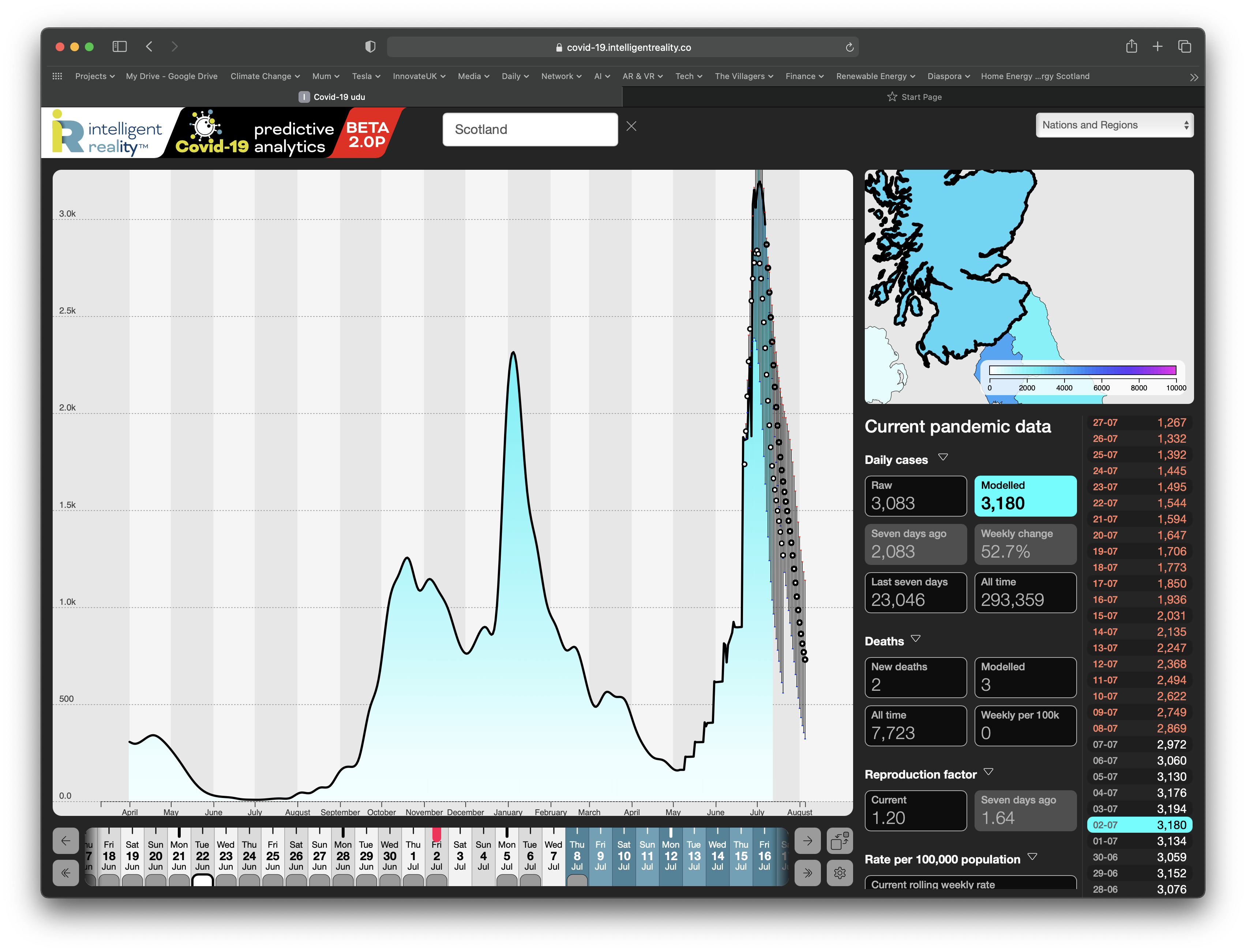
Third Wave Rising
We’ve already shown that our forecasting system has been effective in providing advance warning of the current Third (or Fourth, depending on how you’re counting) wave of Covid-19 cases. With that wave now fully established, we’re looking again at our forecasts, the core data and our dynamic analyses of the pandemic, especially given the latest UK government policy.
With the UK’s rolling weekly case rate now at 238/100k population, up 60% on a week ago, and 40% of the way to the January national peak, we are not reassured. Looking at the behaviour of Chris Whitty’s eyebrows during government briefings, we suspect that neither is he. The current wave is so far unevenly distributed, with urban centres showing the biggest rises, in many cases well above the January peak with, as previously noted, an apparent strong association with those areas most engaged in the Euro 2020 competition. Given little restriction on movement, we believe that these centres of infection are in the process of seeding a ripple of infection across the rest of the country. Continue reading Third Wave Rising
The Impact of G7 and Euro 2020
We’ve now moved from forecast to reality: the UK (and others) are in the throes of a new wave of infections, driven by the Delta variant of the Covid-19 virus. In the UK this has almost certainly been facilitated by both the general relaxation in lockdown and by events such as the G7 Summit and the Euro 2020 competition.
We have now introduced an alert system, which looks for outliers against the current trend in case numbers and pandemic force – this shows that cases and pandemic force spiked in Cornwall following G7 and, as of now, Glasgow (Hampden) just misses out on triggering our alert system and Brent (Wembley) and Edinburgh (the other major source of travelling Scotland fans) both now make our alert list (the red outlined local authorities in the header image). Continue reading The Impact of G7 and Euro 2020
How accurate are our forecasts?
Taking the current rise in infections as an example, our analytic system has, consistently been able to forecast changes in the Covid-19 pandemic across the UK – we started with 14-day forecasts and have now pushed those out to 28 days. We made that change as we improved our algorithms, validated our earlier forecasts and, of course, as our system has had more historical data to work with, it’s got somewhat better at its job.
To validate the forecasts, we measure their daily predictions against what subsequently transpired – these can be displayed in our dashboard by clicking the grey tabs below each date in the horizontal date picker at the bottom.
For that period then, we have forty four 28-day hindcasts, plus the current forecast, from 24 June (today being the 30th – the lag is down to the rolling evolution of data quality for recent days).
For the UK, on thirty six of those forty four days, our forecasts generated a trajectory that closely matches the subsequently recorded change in case numbers, by which we mean effectively tracked the actual case numbers for at least two weeks into the 28-day forecast. We call those Actionable forecasts, in that they’ve proven accurate enough to confidently have taken policy decisions against.
Our header image shows the current forecast for the UK, overlaid with our hindcast for our forecast from 1 June. We think that speaks for itself.
Conscious Uncoupling
As of 11 May, our Covid-19 forecasting system started consistently predicting a coming rise in cases for the UK, driven largely (as it turns out) by the Delta variant of the Covid-19 virus. In the UK this has almost certainly been facilitated by both the general relaxation in lockdown and by events such as the G7 Summit and the Euro 2020 competition. So far, so bad.
Other factors though are far more hopeful – we are seeing a very significant decoupling between case rates, hospital and ICU admissions and in particular death rates. This does demonstrate that the game has changed, and that we need to be rethinking our approach to managing our way out of the pandemic.
That said, government policy in many places still appears to be conditioned by the assumption that the vaccines effectively eliminate transmission, something that simply has not been demonstrated. Continue reading Conscious Uncoupling
Waiting for the Fat Lady
The UK government has just announced that it isn’t going to make a decision on further relaxing Covid-19 restrictions for another two weeks, just as many people were, quite reasonably hoping that the fat lady was, if not in full song, at least warming up for her aria.
Flippancy aside, let’s be clear: delaying a decision like that is utter nonsense, at multiple levels: whether it’s driven by the use of lagging data, the continuing failure to adopt and use effective forecasting (ours or anyone else’s), the pursuit of political dogma, or any combination of these, they’re once again delaying decision making until it’s too late.
Worse, they seem to be relying on the success of the vaccination program to try to pull a largely fictional rabbit out of their hat – the hat that comes with a large label saying, “Wishful Thinking”. But now for the data and analysis… Continue reading Waiting for the Fat Lady
Scotland Rising
So, Scotland is on the rise again. Unfortunately, this is in respect of Covid-19: of the four UK nations, it currently has the highest R Number (1.25 as of the 19th May), versus Northern Ireland’s 1.05, England’s 1.02 and Wales’s 1.04. The UK as a whole is sitting at 1.05.
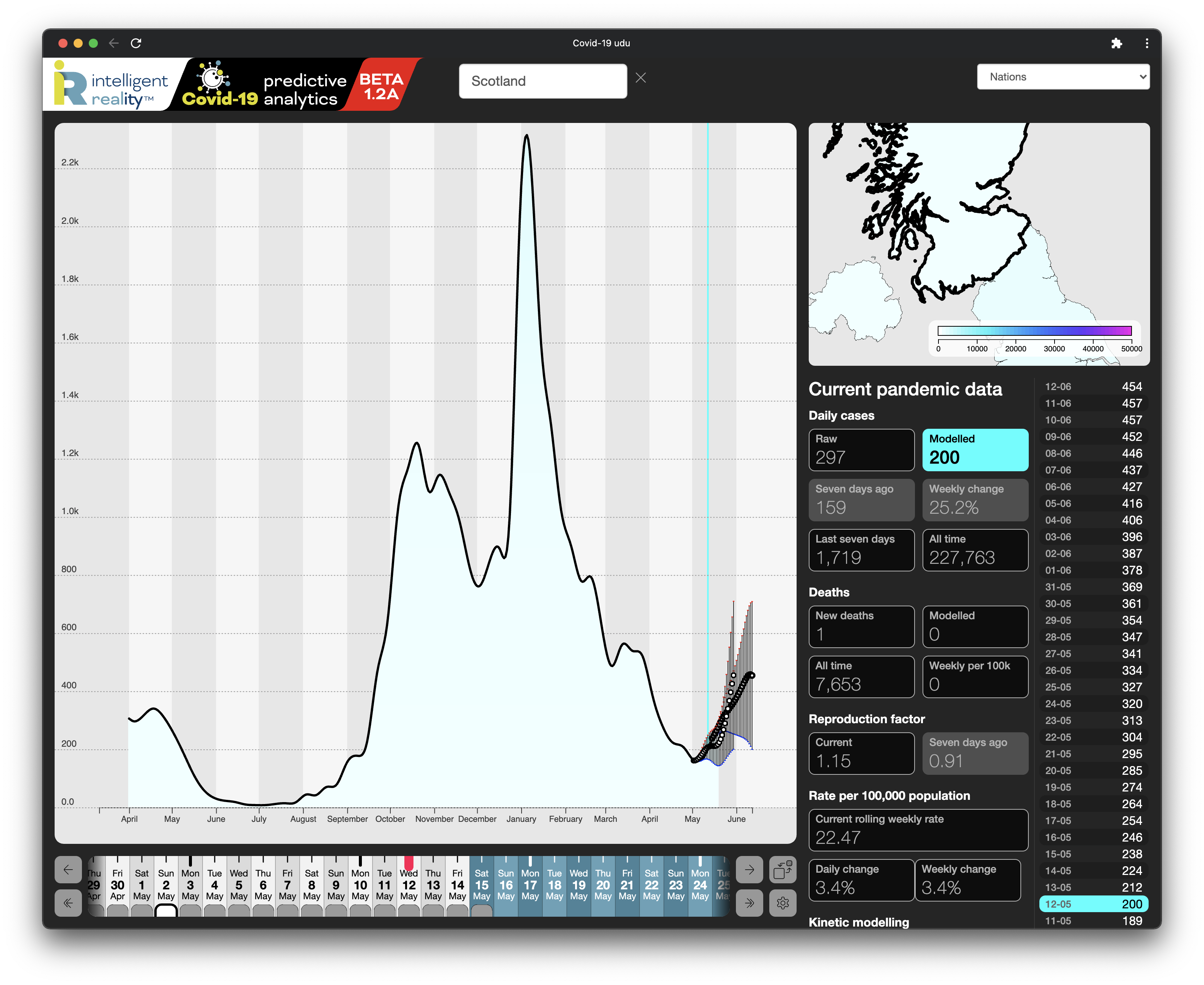
We are however still faced with the situation of governments (in this case, the Scottish Government) making decisions late, and based on data that’s a week or more old, and not apparently using any form of validated forecasting to inform timely decision making.
In case you’re new to our blog, we’ve developed a Covid-19 targeted version of our emergent forecasting system and, in this case, have been forecasting the rise in cases on all but four days since the beginning of May.
Disclaimer: we’re not calling out the Scottish Government here over the governments of other parts of the UK: it’s just that this is our patch and it’s easier to compare the 32 Scottish Local Authorities than the 214 for the whole UK. In our more cynical moments, we think about creating a ‘Political Wishful Thinking vs Actual Data’ index, but it’s a league table that would probably show little variation over time. Continue reading Scotland Rising
Early Warning Onwards
The UK government stated yesterday (13 May) that rising case numbers in the Bolton area were a cause for concern, and that very many of these cases were of the so-called ‘Indian’ variant (B.1.617.2 being the designated variant of concern, with B.1.617.1 and B.1.617.3 under investigation). Here, raw data for case numbers has been available for weeks, with organisations such as the Sanger Institute also providing a very informative breakdown by sequenced variants.
Our analytics platform had identified Bolton and other areas as potential concerns more than two weeks ago and had flagged a correlation between these hot spots and the ethnic balance of the local population, such that, even in the absence of cross-border travel data, of the emerging variants or the situation in India, we were able to provide early warning of emerging problems.
Which very much begs the question as to why the UK government only raised this yesterday, and why travel restrictions from India were only imposed long after the pandemic reached critical mass there. Continue reading Early Warning Onwards
The Last Unknown?
A remaining big unknown in the pandemic is not whether vaccines reduce serious symptoms, hospital admissions and deaths – they do – but whether and to what degree vaccines reduce the ability of those vaccinated to infect others, whilst not being symptomatic themselves. As we’ve noted before, initial data on post-vaccination infectivity was somewhat contradictory, so we don’t yet build the impact of vaccination on infectivity into our forecasting.

